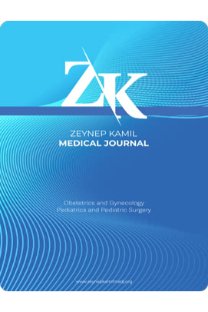Süre içerisinde total laparaskopik histerektomi deneyimi
Laparoskopi, laparoskopik histerektomi, operasyon süresi
Total laparoscopic hysterectomy experience within time period
Laparoscopy, laparoscopic hysterectomy, operation time,
___
- 1. Walsh CA, Walsh SR, Tang TY, Slack M. Total abdominal hysterectomy versus total laparoscopic hysterectomy for benign disease: a meta-analysis. Eur J Obstet Gynecol Reprod Biol 2009;144(1):3–7.
- 2. Nieboer TE, Johnson N, Lethaby A, Tavender E, Curr E, Garry R, et al. Surgical aproach to hysterectomy for benign gynaecologi- cal disease. Cochrane Database of Syst Rev 2009; 8: CD003677.
- 3. Leonard F, Chopin N, Borghese B, Fotso A, Foulot H, Coste J, et al. Total lapa- roscopic hysterectomy: preoperative risk factors for conversion to laparotomy. J Minim Invasive Gynecol 2005;12(4):312–17.
- 4. Sokol AI, Chuang K, Milad MP. Risk factors for conversion to laparotomy during gynecologic laparoscopy. J Am Assoc Gynecol Laparosc 2003;10(4):469–73.
- 5. Hasson HM, Rotman C, Rana N, Asakura H.J. Experience with laparoscopic hysterectomy. Am Assoc Gynecol Laparosc. 1993 Nov;1(1): 1-11
- 6. Süleyman Salman, Yavuz Tahsin Ayanoğlu, Murat Bozkurt, Serkan Kumbasar , Berker Kavşi, Erkin Sertoğlu, Refika Genç Koyucu. Analysis of Total Laparoscopic Hysterectomy Performed in Our Clinic . JAREM 2015; 5: 10-3.
- 7. Davies A, Magos AL. Indications and alternatives to hysterectomy. Baillieres Clin Obstet Gynaecol 1997; 11: 61-75.
- 8. Terzi H, Kale A, Aydın AY. Kliniğimizde gerçekleştirilen laparoskopik histerektomi olgularının klinik özelliklerinin değerlendirilmesi. Kocaeli Tıp Dergisi 2012; 2: 22-5.
- 9. Johnson N, Barlow D, Lethaby A, Tavender E, Curr L, Garry R. Met- hods of hysterectomy: systematic review and meta-analysis of rando- mised controlled trials. BMJ 2005; 330: 1478.
- 10. Mäkinen J, Johansson J, Tomas C, Tomas E, Heinonen PK, Laatikai- nen T, et al. Morbidity of 10 110 hysterectomies by type of approach. Hum Reprod 2001; 16: 1473-8.
- 11. Malik E, Schmidt M, Scheidel P. Complications after 106 laparoscopic hysterectomies. Zentrabl Gynakol 1997; 119: 611-5.
- ISSN: 1300-7971
- Yayın Aralığı: 4
- Başlangıç: 1969
- Yayıncı: Ali Cangül
Şengül Üzen CURA, Tanju OĞUL, FATMA YILMAZ KURT
Yenidoğan ve Süt Çocuklarında Girişimsel Ağrı ve Non-farmakolojik Yönetimi
Derya EMRE YAVUZ, Şule ECEVİT ALPAR
Çiğdem YAYLA ABİDE, İlter YENİDEDE, ENİS ÖZKAYA
FLUVASTATİNİN TAVŞAN KAROTİD ARTERİ YAKA MODELİNDE İNTİMAL KALINLAŞMA ÜZERİNE ETKİLERİ
Mehmet Zuhuri ARUN, Gülnur SEVİN, Şule AYLA, Gülperi ÖKTEM, Günay YETİK ANACAK, Levent ÜSTÜNES
Süre içerisinde total laparaskopik histerektomi deneyimi
Hematolojik Bulgular Olmadan Vitamin B12 Eksikliği
Sema ATEŞ, Feyza Mediha YILDIZ, Erdal SARI, Sevcan KAYAŞ
ÇOCUK HASTADA NADİR BİR GÖĞÜS AĞRISI NEDENİ: SPONTAN PNÖMOMEDİASTİNUM
Abdullah Yazar, Esra Türe, Fatih Akın, Sevgi Pekcan, Dursun Odabaş
Cinsel Yolla Bulaşan Hastalıkların Taranması Ve Tedavi Protokollerinin Karşılaştırılma
Ailevi Akdeniz Ateşi Olan 40 Gebenin Perinatal Sonuçları
Ebru Alici DAVUTOGLU, Ayşegül ÖZEL, HAKAN ERENEL, Rıza MADAZLI
